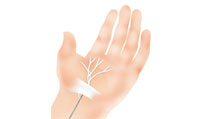Hand, Upper Limb and Microsurgery
Reference Corner [PDF]
The Centre treats a wide range of hand and upper limb conditions from common to more complex problems. Common diseases include trigger finger, ganglion, carpal tunnel syndrome, tennis elbow, golfer's elbow, tendon and nerve injuries. The Centre is also specialized in treating anomalies and deformities such as rheumatoid arthritis, burn and scald, serious nerve injuries and wound problems. Microsurgical reconstruction is a very specialized service that helps to tackle difficult conditions in trauma, malignant tumours and bone and joint infections.
Carpal Tunnel Syndrome
What is carpal tunnel syndrome?
There is a space in the wrist called the carpal tunnel where the median nerve and nine tendons pass from the forearm into the hand.
Carpal tunnel syndrome is a condition when the pressure within the carpal tunnel builds up and causes compression of the median nerve.
Symptoms and signs
Patients may feel numbness, tingling, and pain in the hand, and fingers. Usually the three fingers on the thumb side are affected. It is often worse at midnight and awakes the patient. When it is severe enough, the thumb ball muscles will become wasted.
Causes
Increase in pressure within the carpal tunnel can happen several ways:
1. When it is not serious
Surgical decompression of the median nerve becomes necessary.
The operation
The operation will be conducted under regional or general anaesthesia. The ligamentous structure compressing against the median nerve will be released. Nowadays, the minimal invasive method using a small incision at the wrist and the endoscopic instruments can achieve good relieve of the symptoms. The scar is much better and the recovery is faster. If the wrist is very much deformed or the tendon sheaths are much thickened, traditional method using an incision across the wrist will be used.
Possible complications
| • 腕管綜合症 • 手腳麻痺之原因及治療 • 類風濕關節炎的各種治療 • 常見關節脫位 • 手部及上肢常見病患 | • 關節炎治理新趨向 • Microvascular Reconstruction • Congenital Duplicated Thumb Patient Guide |
The Centre treats a wide range of hand and upper limb conditions from common to more complex problems. Common diseases include trigger finger, ganglion, carpal tunnel syndrome, tennis elbow, golfer's elbow, tendon and nerve injuries. The Centre is also specialized in treating anomalies and deformities such as rheumatoid arthritis, burn and scald, serious nerve injuries and wound problems. Microsurgical reconstruction is a very specialized service that helps to tackle difficult conditions in trauma, malignant tumours and bone and joint infections.
Carpal Tunnel Syndrome
What is carpal tunnel syndrome?

There is a space in the wrist called the carpal tunnel where the median nerve and nine tendons pass from the forearm into the hand.
Carpal tunnel syndrome is a condition when the pressure within the carpal tunnel builds up and causes compression of the median nerve.
Symptoms and signs
Patients may feel numbness, tingling, and pain in the hand, and fingers. Usually the three fingers on the thumb side are affected. It is often worse at midnight and awakes the patient. When it is severe enough, the thumb ball muscles will become wasted.
Causes
Increase in pressure within the carpal tunnel can happen several ways:

- Water retention due to body hormone disturbances. This situation occurs most commonly in ladies of the perimenopausal period. Other causes include pregnancy and low thyroid function
- fractures and dislocations around the wrist joint
- arthritis including rheumatoid arthritis and gouty arthritis
- overuse of the wrist and fingers leading to swelling of the lining of the flexor tendons, called tenosynovitis
1. When it is not serious

- Rest and avoid overuse of the hand and wrist
- Splintage and keep the wrist in neutral position
- Sometimes steroid injection can help
Surgical decompression of the median nerve becomes necessary.
The operation

The operation will be conducted under regional or general anaesthesia. The ligamentous structure compressing against the median nerve will be released. Nowadays, the minimal invasive method using a small incision at the wrist and the endoscopic instruments can achieve good relieve of the symptoms. The scar is much better and the recovery is faster. If the wrist is very much deformed or the tendon sheaths are much thickened, traditional method using an incision across the wrist will be used.
Possible complications
- Wound infection or delayed healing
- Soreness around the incision may last for several weeks or months
- Recurrence of the symptoms
- Damage to the median nerve or the branches of it.

